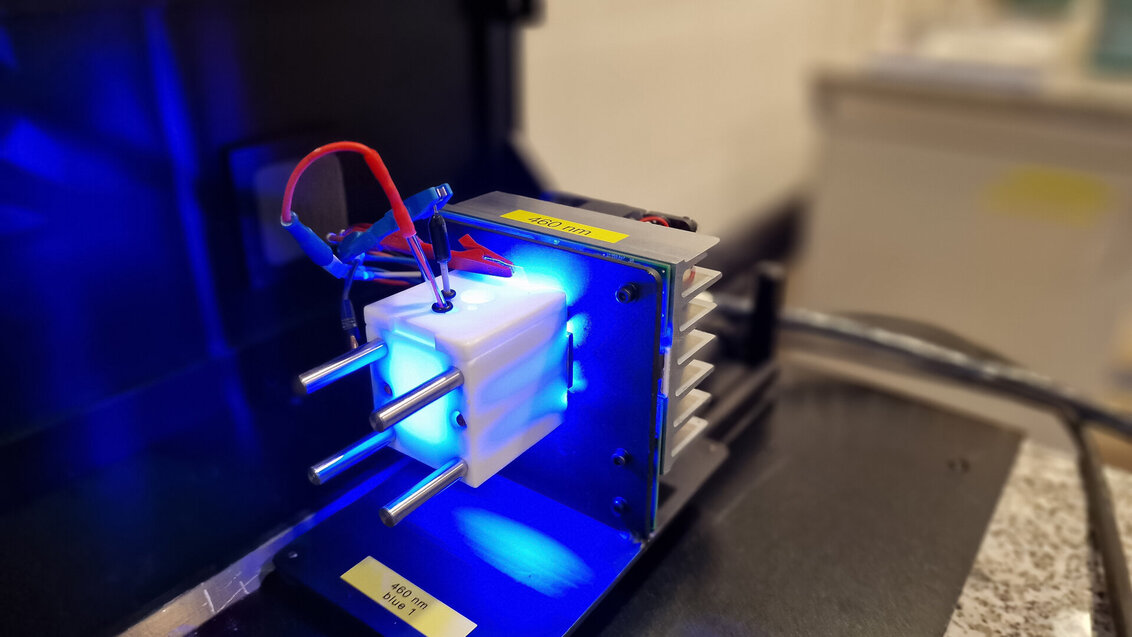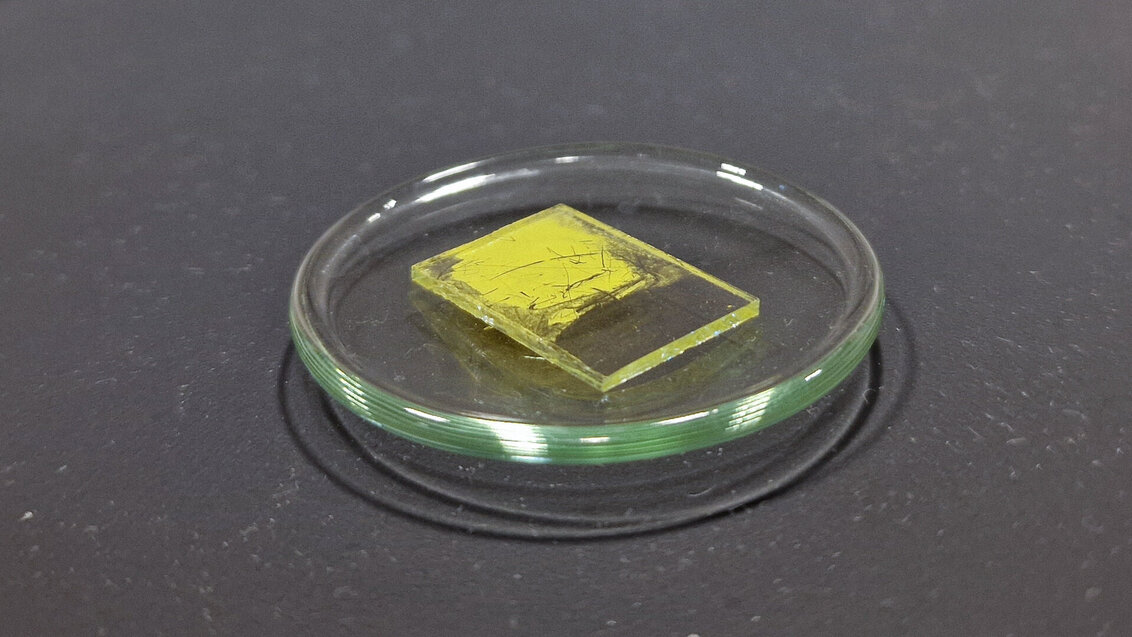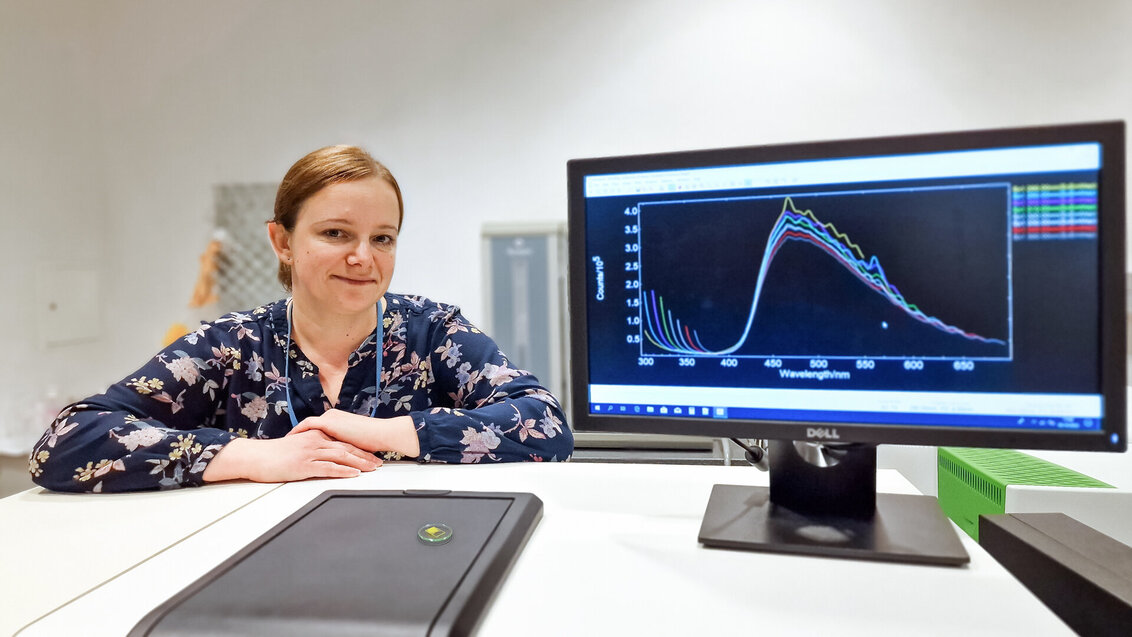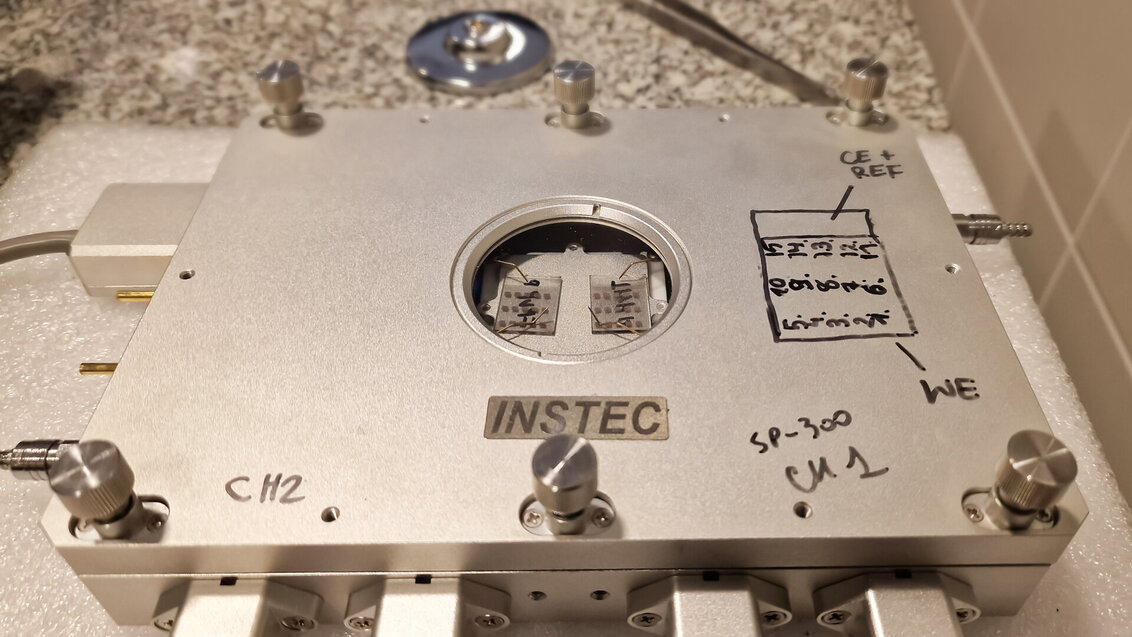
Cuvette for photoelectrochemical measurements, i.e. studying artificial synapses, Photo by Marianna Cielecka
Artificial synapses are circuits based on mechanisms occurring in the nervous system which use the photoelectric effect to process information. Researchers from the AGH University Academic Centre for Materials and Nanotechnology have an idea on how to broaden their capacities in this respect. The solutions developed by them may in some applications be an alternative to digital artificial intelligence or e.g. serve for building a bionic eye.
Eyesight is one of the most significant tools that nature has equipped us with for life. We can see owing to the light reflected from the surroundings being received by photoreceptors in the eye. Such information is then transformed into an electrical impulse which is transferred to other cells of the nervous system via synaptic connections, and our brain converts it into images. Scientists are trying to mimic this mechanism by creating artificial synapses which could be used in information processing. The systems based on them, unlike the computers we use, would be free of the so-called von Neumann bottleneck. This is because they can store and process information, while the computing power of today's devices is limited by the need to transfer data between memory and processor.
From the photoelectric effect to an artificial synapse
An artificial synapse is essentially a simple circuit in the form of an electrode coated with a thin layer of a photosensitive semiconductor, which generates a current when exposed to a light pulse. The observed phenomenon is associated with a change in the electron structure of the material. In semiconductors, electrons occupy two bands of electron states: the valence band and the conduction band, separated by the band gap. Electrons on the valence band are bound to nuclei in atoms, and therefore, cannot participate in the flow of current. However, when they absorb some amount of light from photons, they get moved to the conduction band. Vacant places can participate in the flow of current, thereby increasing the conductivity of the material, or be taken by free electrons from the conduction band.
“On the one hand, it is then that the recombination processes occur, and on the other hand, electrons are transferred to the electrode and we record a signal in the form of photocurrent,” explains Dr. Agnieszka Podborska of the Academic Centre for Materials and Nanotechnology at the AGH University, who, together with her team, is conducting research on the possibilities of using semiconductor materials in artificial synapses.
Artificial synapse model, i.e. a glass ITO electrode coated with bismuth vanadate, Photo by Marianna Cielecka

The photoelectric effect itself has been known for a long time and used practically in solar batteries, photodiodes, and matrices of digital cameras, etc. But how the phenomenon of generating photocurrent can be used for memorising and processing information? Depending on the material used and the parameters of the light beam, the semiconductor’s response to a given impulse can vary. Scientists have increasingly improved tools for capturing signals and analysing them. This, in turn, opens the possibility of using light to encode various data on the synapse.
“In the semiconductor, electrons can also move to trap states. They get trapped there, do not recombine, do not give any signals. If after the first and the following light impulses the electrons move towards trap states, the observed signal is weaker. As these levels fill with electrons, its strength increases. At one point we reach plateau and we cannot achieve greater signal intensity. When the signals are stronger and stronger, we are talking about the process of learning, and when they get weaker – of forgetting,” Dr Podborska explains.
How scientists teach the pattern recognition system
In perfect conditions, the response of semiconductors to light impulses with fixed parameters should always be the same. The researchers from the AGH University ACMiN took advantage of this correlation by creating a system based on an electrode coated with cadmium sulfide, and then, they demonstrated its ability to recognise handwritten numbers. A paper on this subject was published in the Molecules journal. Scientists used as many as 100 samples, with each one of them numbered from 1 to 9. Each sample was divided into pixels in such a way that individual fields contained either the background (white) or a fragment of a sign (black). Then, the images were transformed into a stream of bits with each number coded on the synapse with the use of light impulses.
Dr Podborska described how the device recognises patterns:
“If a pixel is white like the background, it’s value is ‘0’, if it is a quadrant of a sign, then it is ‘1’. Then, we learn how the system reacts depending on the modulation of the light. We create a certain sort of maps and based on them we determine whether the signal generated by our material is replicating the studied shape. In the following step, we prepare data bases from such individual maps. When we later take a randomly selected sign, we can compare whether the response of the system coincides with any of the previous ones. Here, the statistics are of the essence – to get a good idea of the system's responses, you need to take hundreds or even thousands of measurements.”
Will an artificial synapse become sensitive to colours?
In the abovementioned example, the AGH University employees shone light with a fixed wavelength and intensity. However, as they showed in their following publication, which was published in the prestigious journal Nature Communications, the intensity of the light also affects the changes in the electron structure of semiconductors. The described LIIPS effect (Light Intensity Induced Photocurrent Switching Effect) gives scientists completely new possibilities in terms of coding and information processing. Dr Podborska aims to use them within the project she is currently managing, which constitutes a continuation of the research previously conducted in the AGH University ACMiN.
“Earlier, we used to shine a light with constant intensity, now we want to change it. While previously we were able to recognize black and white images, now we will try to extend this to grey tones, or even other colours. It all depends on the response of the material,” the AGH University researcher declares.
Dr Agnieszka Podborska, Photo by Marianna Cielecka

This time, however, the team led by Dr Podborska will work with other types of semiconductors. The scientists are particularly hopeful about bismuth vanadate.
“We are looking for materials which will generate repeatable signals and will be characterised by different trap states or greater resistance to light, which is a significant issue in this field. Cadmium sulfide used before is susceptible to photocorrosion. As a result, its structure is destroyed, which excludes it from practical applications. Bismuth vanadate seems to be a more stable material in this respect,” the researcher explains.
Synthesis of imperfect crystals key to success
As part of the project, the AGH University scientists do not aim to only study how the already know materials react to light. They also want to introduce modifications which will broaden the spectrum of their responses in that regard.
“By doping, we can influence the crystallographic structure of material which will generate additional trap states. We can also modify the outer surface of the semiconductor for example with organic particles which will have the function of a donor or acceptor of electrons, i.e. they will catch or deliver electrons to the semiconductor. Our objective is to thoroughly investigate these mechanisms because, depending on the selected methods of synthesis, we can obtain more or less defective materials,” Dr Podborska clarifies.
Thermoelectric device, Photo by Marianna Cielecka

The researcher stipulates that defects in the material do not constitute a defect in this case, but condition the ability of the system based on them to learn:
“Materials need to have some defects, because if they had the structure of a perfect crystal, we would not observe the photocurrent phenomenon. If there were no trap states, the recombination processes would be more efficient than the induction processes of the semiconductor, and there would be an immediate recombination without intermediate states, after which, for example, the semiconductor would return to the ground state. Then, we would not be able to use such materials to process information.”
Light can be a carrier of various information
In the AGH University ACMiN, there is also research being conducted on using artificial synapses to recognize patterns other than images.
“These can be for example sounds, namely speech and music. In our team, by means of the research we are conducting, we are trying to translate sounds into light impulses at the right frequency. By registering the sounds generated by the semiconductor, we are able to recognise whether it is a dissonance or a consonance. I hope that our research will make a step forward and we will manage to, for example, connect a few synapses from different semiconductors which will react in different ranges. Then, we will be able to recognise more complicated patterns e.g. three-dimensional ones. I can imagine that, but I do not have a technical solution on my mind yet,” Dr Podborska says.
The time will tell whether, as technology develops, artificial synapse-based circuits will replace digital artificial intelligence and computers in some applications, or whether they will remain just a curiosity. Regardless of that, a more thorough understanding of the mechanisms behind the photoelectric effect may lead to increased possibilities for shaping the parameters of semiconductors and result in new prospects for their application not only in optoelectronics.
The project on the light intensity-induced photoelectrochemical switches for pattern regonition (“Przełączniki fotoelektrochemiczne sterowane intensywnością światła do rozpoznawania wzorów”) was co-financed as part of the OPUS-24 Programme by the National Science Centre.
 Pre-election meeting with a candidate for the position of rector
Pre-election meeting with a candidate for the position of rector  Agreement on cooperation with OPAL-RT
Agreement on cooperation with OPAL-RT  Krakow DIANA Accelerator consortium members with an agreement
Krakow DIANA Accelerator consortium members with an agreement  Meeting with the Consul General of Germany
Meeting with the Consul General of Germany  More Academic Sports Championships finals with medals for our students
More Academic Sports Championships finals with medals for our students  Professor Jerzy Lis re-elected as AGH University Rector
Professor Jerzy Lis re-elected as AGH University Rector  Launch of AGH University Student Construction Centre
Launch of AGH University Student Construction Centre  Bronze for our swimmers at Academic Championships
Bronze for our swimmers at Academic Championships